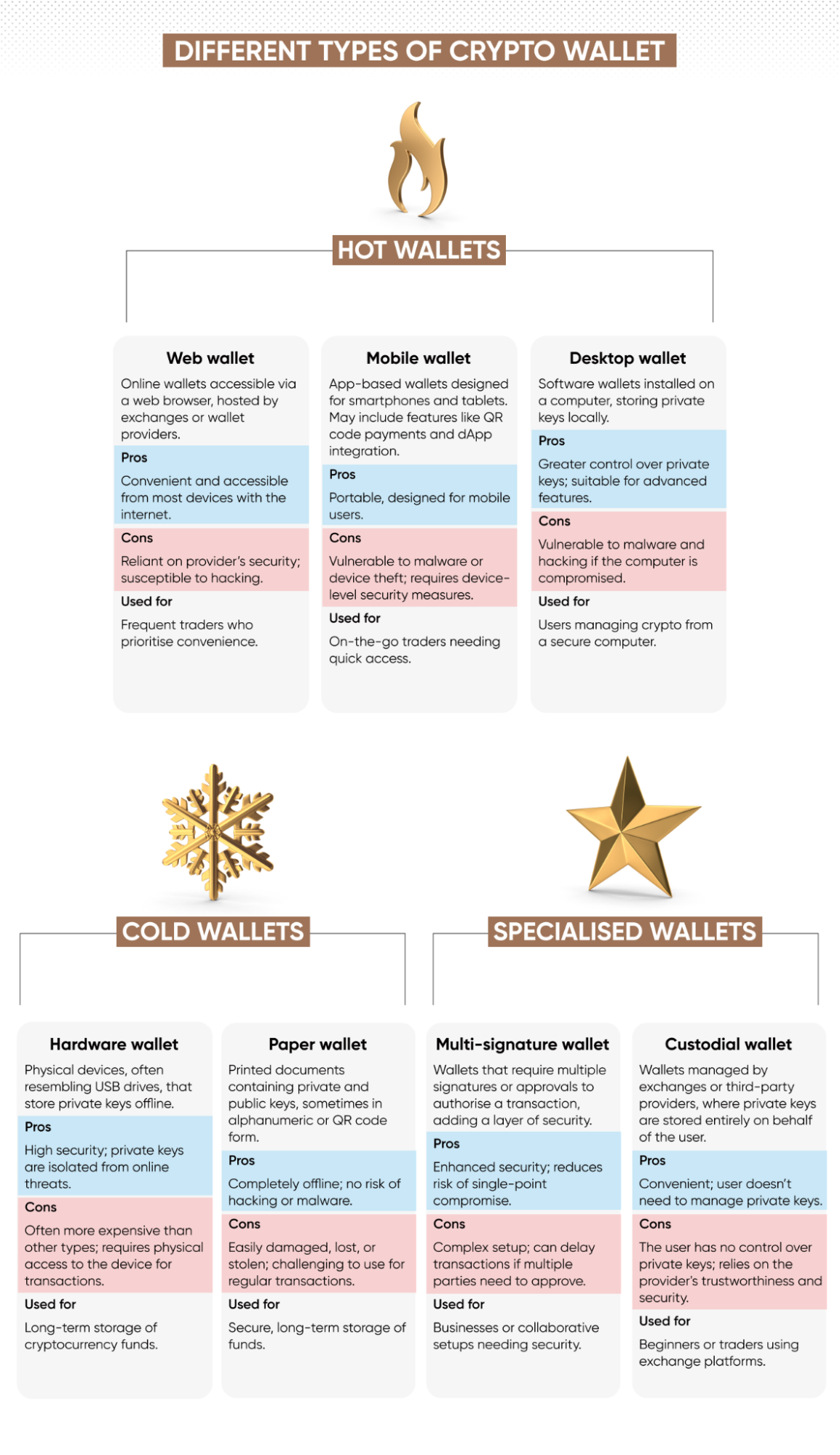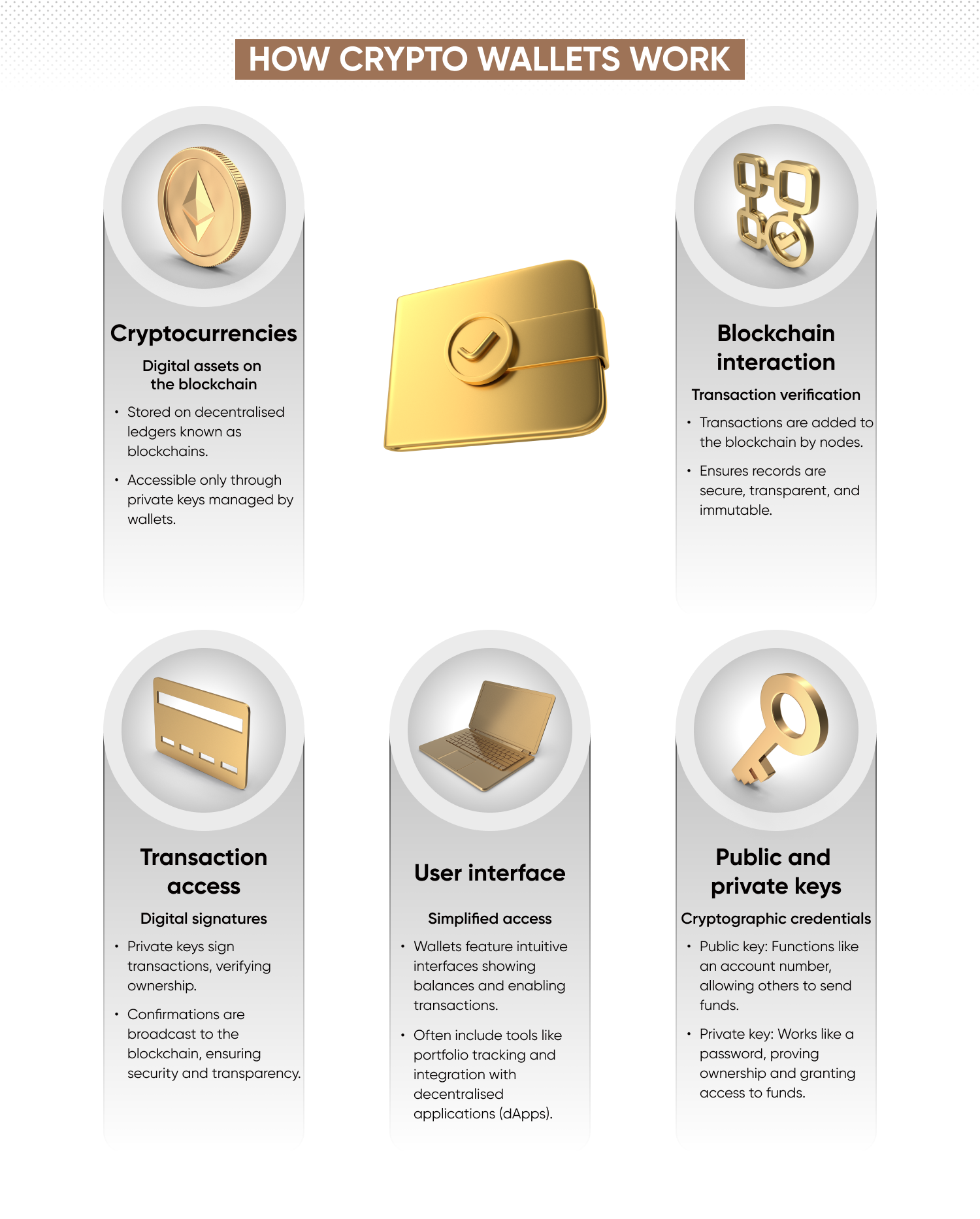What is a crypto wallet and how does it work?

Discover how to choose the best crypto wallet, including tips for beginners, the different types of crypto wallet, and how to open one.
What is a crypto wallet?
A crypto wallet is a digital tool that allows users to manage, send, and receive cryptocurrencies securely. These wallets generate and manage two types of cryptographic keys – private keys and public keys – which authorise cryptocurrency transactions and prove ownership of funds. Crypto wallets come in various forms, including software-based applications and hardware devices. Each type of wallet has distinct characteristics regarding security, accessibility, and ease of use.
Choosing the right crypto wallet is an important decision for anyone entering the market.
What are the different types of crypto wallet?
Crypto wallets come in two main forms: hot wallets and cold wallets. Hot wallets are connected to the internet, making them convenient for frequent transactions but potentially vulnerable to cyberattacks. Cold wallets, on the other hand, are offline storage solutions, prioritising security over ease of access.
Each type of crypto wallet is designed to help users manage their funds in the cryptocurrency market. Here’s how they compare:

Hot wallets
Connected to the internet, and may be used for cryptocurrency trading and frequent transactions. This connectivity can also expose them to cybersecurity risks.
Cold wallets
Offline, prioritising security by limiting exposure to internet-based threats. They may be suitable for long-term storage or holding significant amounts of cryptocurrency.
Specialised wallets
Include features such as multisignature functionality or custodial arrangements to address specific security or usability needs.
How does a crypto wallet work?
A crypto wallet is a tool that facilitates access to cryptocurrencies via the blockchain.
Cryptocurrencies themselves are not stored on blockchains; instead, blockchains record transactions and balances. Crypto wallets hold the private keys, which act as a digital signature, prove ownership of, and grant access to the funds.
Here’s how a crypto wallet works:
Public and private keys
When someone creates a crypto wallet, it generates two cryptographic keys: a public key and a private key.
-
The private key is a critical credential and must be kept secure; it’s required to access and manage funds and cannot be changed if compromised.
-
The public key is mathematically derived from the private key and functions like an account number, allowing others to send you cryptocurrency.
Always keep your private key secure, as losing it could result in permanent loss of access to your cryptocurrency.
Access to funds
When a user logs in to their wallet to send or receive cryptocurrency, the private key is used to sign transactions. This digital signature confirms to the blockchain network that the user owns the relevant wallet address (and its contents).
Blockchain interaction
Cryptocurrency transactions, including those from crypto wallets, are usually broadcast to a blockchain for processing. Some wallets may use intermediaries or second-layer solutions to facilitate transactions more efficiently.
During this process, nodes (computers running the blockchain software) verify the transaction and add it to the blockchain ledger. Nodes validate transactions and ensure transparency, while consensus mechanisms and cryptographic principles ensure immutability.
Types of storage
Wallets can be connected to the internet (hot wallets) or kept offline (cold wallets). Hot wallets are useful for quick access and frequent trades, while cold wallets – like hardware wallets or paper wallets – are designed for long-term storage and enhanced security.
User interface
Many crypto wallets have user-friendly interfaces that aim to simplify the complexities of blockchain technology; they show funds balance, facilitate transactions, and often provide additional features like portfolio tracking and integration with decentralised applications (dApps).
In essence, a crypto wallet works as a personal gateway to the blockchain, used to manage keys for secure and efficient transactions.
To better understand how wallets interact with different cryptocurrencies, you can explore our guides on Bitcoin, Ethereum and TrumpCoin.
Learn more about the cryptocurrency market and read our comprehensive cryptocurrency trading guide.

Which crypto wallet is best for beginners?
If you’re a beginner, choosing a cryptocurrency wallet might seem confusing. However, choosing the best crypto wallet isn’t too different for seasoned traders and beginners – it’s essential to weigh ease of use against security.
Start with a user–friendly wallet – Designed with intuitive interfaces and simple navigation. Some beginner-friendly wallets also provide guided tutorials and FAQs to help you get started.
Choose a wallet with multi-device compatibility – Works across multiple devices, such as mobile, desktop, and web browsers. This ensures you can access your funds conveniently wherever you are.
Prioritise wallets with strong security – Features like two-factor authentication (2FA) and encrypted private keys are essential. For enhanced protection, some wallets may even include biometric login options.
Find a wallet with built-in customer support – With 24/7 support, ideally with multiple communication options like live chat, email, or in-app help centres for quick assistance.
How to create a crypto wallet
Creating a crypto wallet is straightforward. With the right approach, you can have a secure place to store and transact your cryptocurrencies:
- Choose your wallet typeBegin by deciding whether you prefer a hot wallet (online and convenient for frequent transactions) or a cold wallet (offline and focused on security).
- Download or registerVisit your chosen wallet provider’s official website or download its mobile app. For non-custodial wallets, you may not need to sign up – these typically generate wallets instantly without requiring personal details.
If using a custodial wallet, look for a ‘sign up’ or ‘create wallet’ button and click on it. You’ll then be prompted to enter personal details or verify your email. Wallets integrated with exchanges may require ID verification as part of their verification process. - Secure your private keyOnce your wallet is created, it will generate a private key or seed phrase. Keep this confidential – consider writing it down, storing it offline in a safe place, or using a hardware wallet or encrypted backup for added security.
Remember, if you lose your private key, you could lose access to your funds permanently. - Enable securityFor extra peace of mind, set up security features such as two-factor authentication (2FA) or biometric access. This adds a layer of protection against potential threats.
- Fund your walletBefore you can send or receive cryptocurrency, you’ll need to add funds. Deposit digital assets from an exchange or transfer them from another wallet. Always double-check addresses and ensure your wallet is compatible with the cryptocurrency you’re transferring to avoid irreversible errors.
- Maintain your walletOnce your wallet is active, keep its software up to date, monitor your balance regularly, and stay alert to phishing attempts. If you’re serious about crypto, consider exploring additional security steps like hardware wallets or multisignature setups.
Want to learn more about crypto trading? Explore our step-by-step crypto course designed to help you understand the basics to the advanced concepts.
FAQs
How does a crypto wallet work?
A crypto wallet works by securely storing the private keys needed to access and manage cryptocurrencies on the blockchain. While cryptocurrencies themselves remain on the blockchain, your wallet stores the private keys that grant access to them. When you use your wallet to send or receive funds, the private key generates a digital signature to verify ownership and authorise transactions. In addition, many wallets offer recovery mechanisms, such as seed phrases, to help you regain access if your private keys are lost
How do I get a crypto wallet?
You can get a crypto wallet by downloading an app, purchasing a hardware wallet, or signing up with a crypto exchange that offers a built-in wallet. Popular options include mobile wallets, desktop wallets, and hardware wallets. Choose a wallet that fits your trading needs, whether it’s for frequent transactions or long-term storage.
Which crypto wallet is best for beginners
For beginners, user-friendly wallets with intuitive interfaces and strong security features are ideal. Hot wallets, such as mobile or web-based options, are often a good starting point due to their ease of use. Be aware that hot wallets are more vulnerable to hacking than cold wallets, like hardware wallets. If security is a top priority, consider starting with a cold wallet despite the learning curve. Look for wallets with built-in tutorials, multi-device compatibility, and customer support to help you navigate the world of crypto safely and confidently.
Is it worth having a crypto wallet?
Having a crypto wallet may be beneficial depending on your needs as a cryptocurrency user. If you actively hold or trade cryptocurrencies, a wallet offers more control over your funds compared to keeping them on an exchange. Wallets also provide added security features, such as private key management and offline storage options. However, if you prefer speculative trading through platforms like CFDs (contracts for difference), a crypto wallet may not be necessary, as you aren’t dealing with the actual ownership of cryptocurrencies.